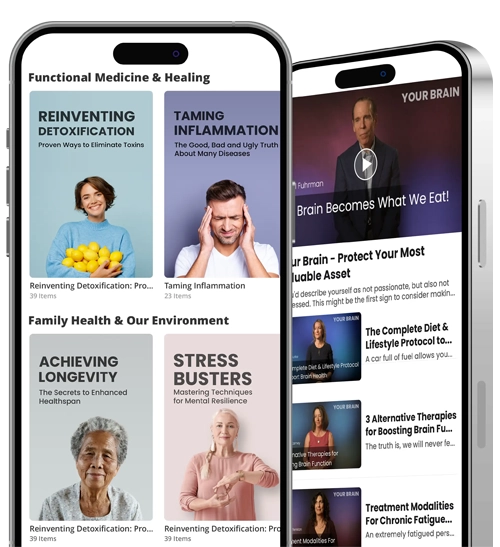Learn Why Not All Inflammation is Bad for You
Home
 Blog
Blog
 Health
Health
 Organs & Systems
Organs & Systems
 Immune System
Immune System
 Learn Why Not All Inflammation is Bad for You
Learn Why Not All Inflammation is Bad for You

When you hear about “inflammation”, it’s usually put in a negative context. Pop open Google Search, and you’ll find MILLIONS of people searching for inflammation and its link to diseases like cancer, depression, heart disease, colon cancer and more.
According to experts, inflammation is “at the root of most diseases“. It has long been known to play a role in arthritis, asthma, Crohn’s disease, and other allergic diseases, but recent studies have discovered that inflammation also is involved in many more conditions—from Alzheimer’s to Parkinson’s to diabetes to high cholesterol.
In this discussion you will learn about the various types of inflammation and in what cases inflammation can actually be GOOD for you! You will also find out what new discovery about your skin could lead to major breakthroughs in disease science and innovative therapy.
Inflammation and Your Body
Inflammation is your body’s natural response to threats. The swelling occurs when cells in your body are damaged, by trauma, strain, bacteria, viruses, and so on. Your body causes swelling around the damaged area in order to prevent further damage. The inflammation helps to protect the damaged area while your body repairs the injury or eliminates the threat.
Inflammation comes in two flavors:
- Acute, a quick form of inflammation that appears quickly (such as after an injury) and disappears within a few days.
- Chronic, a slow, long-lasting form of inflammation that takes time to develop and can last for months or years at a time.
Chronic inflammation is usually the result of your body’s inability to remove the threat or repair the damage. THIS is the type of inflammation that is linked to diseases.
Acute inflammation, on the other hand, is your body’s way of protecting itself and promoting repair. In fact, as one study found, it can actually help to speed up healing in the future!
Researchers from The Rockefeller University conducted experiments on mice, testing how inflammation helped to speed up skin repair. The mice that had experienced inflammation in the past healed twice as quickly from wounds. Even if the injury had occurred more than 6 months before (the equivalent of 15 human years), the inflammation led to better healing!
Get FREE Access!
We are on a mission to change your life by providing you with curated science-backed health tips, nutrition advice and mouth-watering recipes. Sign up to receive your 3 starter gifts and get exclusive access to new weekly content for FREE:

Free eBook
to boost metabolism

4 Shopping Guides
for every diet

22 Free Recipes
to beat sugar addiction
 Subscribe now
Subscribe now
When analyzing this occurrence, the researchers found that stem cells in the skin “remembered” the damage from the previous injury or wound. When injured or wounded again, the memory in the stem cells kicked in and healed the damage much more quickly.
Want to guess what “trained” the stem cells to react that way? The skin stem cells take their cue from the body’s inflammatory response—meaning that the initial inflammation caused by the wound was the signal to the stem cells that they needed to respond again the same way in the future. The inflammation basically increased the sensitivity of the stem cells, causing them to respond more quickly when the same spot was wounded again.
It’s important to note that this skin stem cell “memory” could also play a role in conditions like psoriasis and other inflammatory skin diseases. However, the fact that “the skin remembers” is a fascinating discovery that could lead to some major breakthroughs in a number of conditions. According to the lead researcher, “A better understanding of how inflammation affects stem cells and other components of tissue will revolutionize our understanding of many diseases, including cancer, and likely lead to novel therapies.”
Reducing Inflammation
When the topic of “reducing inflammation” comes up, it’s ONLY referring to the chronic inflammation that leads to disease. Usually, acute inflammation is called “swelling”, especially in the context of injuries.
To reduce acute inflammation:
- Remember PRICE. P for protection to prevent further injury, R for rest, I for application of ice (cold can reduce swelling), C for compression to prevent an increase in blood flow to the injury, and E for elevation (again to reduce blood flow).
- Apply analgesic creams. For swollen muscles or joints, analgesic creams can be life-savers!
To reduce chronic inflammation:
- Avoid inflammatory foods. These may include dairy products, trans fats, processed meats, rancid oils, sugars, and artificial sweeteners. All of these can have an inflammatory effect on your digestive system, as well as your body’s cells.
- Increase antioxidant intake. More antioxidants = less oxidative damage = less chronic inflammation. Antioxidants are meant to be ingested as well as applied to your skin!
For other science-backed truths and action plans, join ZONIA video streaming platform today where our health and nutrition experts provide easy to follow advice and recommendations on how to kick start your transformation!

We created ZONIA because we believe that everyone deserves to be empowered with the education and tools to be healthy and happy. Zonia's original videos and personalized transformation programs by our health & wellness experts will help you achieve this mission. Click on the button below to get started today:






